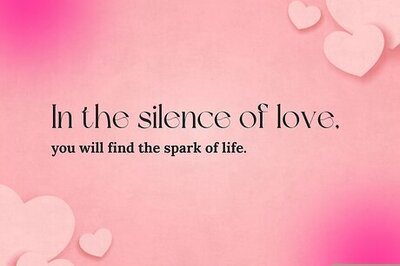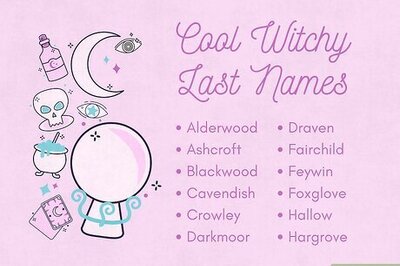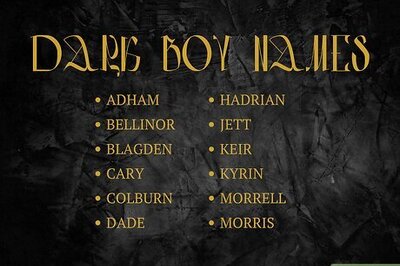
views
Puns
Also known as double entendres (or more generally, just “wordplay”), a pun is a type of joke where there are two meanings based on how a word is pronounced or interpreted. Puns are often good-hearted and silly, but they come in more intense variants, too. Example: “Two worms had a race. It ended in a tie.” (The “tie” here could refer to the race ending with two participants finishing at the same time, or a knot, implying the worms got literally tied up.) Famous Comedians: David Letterman and the other late-night show comedians often rely on puns. Bo Burnham and Todd Barry are also punny comedians.
Wit
Wit is hard to conceptualize for a lot of people, but it basically boils down to smart comedy. If a joke is intellectually engaging, it’s probably witty. As Garavito says, “I wouldn’t say the goal should be to ‘show off’ your intelligence. It needs to come from a playful place, and maybe lightly challenge the status quo…So it should be playful and a little bit challenging, but in a safe, fun way. Not intimidating.” Example: “You don’t need to be humble. You aren’t that great to begin with.” Famous Comedians: John Mulaney, Stavros Halkias, and Sarah Silverman.
Satire
Satire involves making something (or someone) seem ridiculous by playing up a certain quality. It’s all about the intersection where a legitimate criticism meets an over-the-top demonstration of a problem. Because satirical comedy lends itself to larger and more complex themes, entire works of art often engage in a single satirical flourish. Examples include Gulliver’s Travels, Idiocracy, any article by The Onion, or American Psycho. Example: “We can’t afford to forgive student loans. If we do that, where are we going to get the money to bail out the bankers on Wall Street?” Famous Comedians: Jon Stewart, Stephen Colbert, John Oliver, and Weird Al Yankovic.
Physical Humor
Physical humor is basically any kind of comedy where the joke is a movement or action. If you’ve ever laughed at, say, a baby falling down in a goofy way, you’ve laughed at physical humor. But while people often assume physical comedy is exclusively about people getting hurt in silly ways, physical humor includes things like clowns and ventriloquists. Example: Mimes are a perfect example; they rely entirely on physical humor since they can’t speak. Famous Comedians: Robin Williams and Gallagher were both famous for their physical humor.
Slapstick
Slapstick comedy is a type of physical comedy. In fact, it’s what most people picture when they hear “physical comedy.” Slapstick refers specifically to physical comedy where the joke involves over-the-top or exaggerated physical movements. Example: Anything from the Three Stooges is the classic example here. Charlie Chaplin’s work is often very slapstick, as well. Famous Comedians: Buster Keaton, Benny Hill, and Jim Carrey.
Dry Humor
Garavito explains, “Dry humor is when you’re so grounded in your joke that the listener really enters your frame of mind. Sometimes, it’s so absurd or flat that people step out of their perspective and into yours. It’s really about how fun your perspective is, so that others want to join you in it.” Dry humor is all about delivery. The flatness and lack of a humorous tone are essential. Example: “The human lifespan is only one minute. It just happens to refresh every time you take a breath.” Basically anything spoken by a character who isn’t Dwight or Michael in The Office, as well. Famous Comedians: Steven Wright, Mitch Hedberg, and Demetri Martin.
Toilet Humor
Aka “potty” humor, toilet humor refers to any kind of comedy where the funny part has to do with something gross. Usually, it’s something related to the human body (the iconic “fart joke” comes to mind), but it’s not a prerequisite so long as the comedy pertains to something gross and viscerally physical. Example: “When does toilet paper keep wiping? When it’s on a roll!” Famous Comedians: Tim Heidecker, Larry the Cable Guy, and Daniel Tosh.
Dark Humor
Dark, or “black,” comedy involves the nastier parts of the human experience. This is where you’ll find the jokes about death, pain, suffering, and all the other unpleasant elements of the human experience. The underlying goal of dark humor is often (but not always) to alleviate some of the pain by sharing it with others. By joking about the things that hurt us, we get a little bit closer to healing. Example: “Why didn’t the lifeguard save the hippie who was drowning? He was just too far out, man.” Famous Comedians: Lenny Bruce, George Carlin, Jimmy Carr, and Ali Wong.
Cringe
A Millennial and Gen Z favorite, cringe comedy is the basis for such beloved shows as The Office and Parks and Recreation. Basically, cringe is anything that makes you scrunch your face and want to leave the room in secondhand embarrassment. The humor comes from the awkward, weirdly sad, and distressing moments where you’re witnessing something uncomfortable. Example: “My girlfriend said she wanted to take things to the next level, so I brought a ladder with me to our next date.” Famous Comedians: Tim Robinson, Larry David, and Ricky Gervais.
Irony
Irony is a surprisingly complex type of comedy, but at its most basic, it’s all about the difference between what you expect and what actually happens. Almost every comedian utilizes irony, so instead of listing comedians, we’re going to break down the three primary types of irony: Situational Irony: When the outcome of a scenario is the opposite of what is expected. Example: A cop pulls over a speeding vehicle specifically to ask the driver where they got their sweater from. Dramatic Irony: When the audience knows something that characters in a story do not. Example: We know there’s a cop who became a police officer specifically to force fashion advice out of people. We see him pull over a speeding driver. The driver is freaking out, but we know the cop just wants to know about his cool sweater. Verbal Irony: When someone says the opposite of the thing they mean. Example: The driver of a car is wearing a hideous sweater. The cop says, “That’s a really nice sweater.”
Observational Humor
Observational humor refers to any kind of comedy that revolves around life’s little everyday quirks. If you’re listening to a joke about peanuts on airplanes or a story about a bad driver who doesn’t know how to merge, it’s observational comedy. Example: “Why does the water in public bathroom sinks either take forever to get hot or come out scalding? Why is there no in between?!” Famous Comedians: Jerry Seinfeld, Bill Burr, and Taylor Tomlinson.
Topical Humor
Topical humor shares a lot of the same DNA as observational humor, but topical comedy always pertains to something in current events. Some topical jokes may focus on a larger social or political conversation, too. Example: “The biggest TikTok challenge is getting your kid to take a break from their phone.” Famous Comedians: Dave Attell, Argus Hamilton, and Pete Holmes.
Dad Jokes
Dad jokes are a type of pun. They’re notorious and popular because they’re so dumb—in the best way possible. The trick with a dad joke is that the punchline has to be a pun so silly and contrived that only a goofy old guy could possibly find it funny, which then elevates the joke and makes it funny on a more elaborate level. The important part, as Garavito explains it, is that the joke has to be kind of wholesome. He says, “A good dad joke feels like it comes from someone who cares—like a father figure being playfully silly. It’s not imposing or edgy.” Example: Garavito’s favorite is, "I know a joke about lions, but if I told you, I’d be lion.” Famous Comedians: Jim Gaffigan and Nate Bargatze are both popular comedians who tell the occasional dad joke.
Highbrow Humor
Highbrow humor is a general category for jokes that are considered “high class” or fancy. It often involves complex topics or elaborate satire, and it may not be immediately noticeable that a joke is even being told at first. Example: “Yanis Varoufakis, Slavoj Zizek, and David Graeber walk into a bar. The manager of the bar throws up his hands and says, ‘Is it possible to serve you three without being critiqued for the imbalance between labor and the owning class?’” Famous Comedians: Mark Russell, Stewart Lee, and Woody Allen.
Lowbrow Humor
Lowbrow comedy is just…not smart. It’s any joke that requires basically zero education or background information to understand, and often the joke is even funnier than it otherwise would be due to the stupidity of the joke. Keep in mind that lowbrow humor is not bad. It’s just a specific type of comedy. Example: “A man walks into a bar with a beer. The bartender says, ‘Hey! You can’t bring that in here!’ The man looks at the drink confused and says, ‘Sorry, I thought we could drink in here.’” Famous Comedians: Jimmy Fallon, Carlos Mencia, and Bert Kreischer.
Surreal Humor
Surreal humor is all about finding the humor in the absurd. It will often blend irony and satire, although some surreal humor is just funny because it’s so weird. However, unlike anti-humor or esoteric humor, surreal humor maintains at least a modicum of real-life logic. Shows like Aqua Teen Hunger Force and Smiling Friends are good examples of surreal humor. Example: “What do a duck and a bicycle have in common? They both have handlebars.” Famous Comedians: Jenny Slate, Groucho Marx, Natalie Palamides.
One-Liners
A one-liner refers to any joke that can be completely expressed in a line or two. These jokes are often puns and silly plays on words, but they can occasionally convey some deeper values or ideas. Ironically enough, one-liners often use two sentences: one for the setup and one for the punchline. Example: “I went to buy some camouflage pants, but I just couldn’t find any.” Famous Comedians: Rodney Dangerfield, Steven Wright, and Zach Galifianakis.
Anecdotal Humor
Anecdotal humor is perhaps the most popular style of comedy for stand-up comedians. At its core, it’s really just storytelling. An anecdote refers to a short story you were personally involved with, so anecdotal humor is just comedic stories about yourself! Example: “I was on an airplane last week and I saw that a man had brought a bag of pancakes onto the plane…” Famous Comedians: Maria Bamford, Kyle Kinane, and Tig Notaro.
Hyperbole
Hyperbole is a rhetorical device where you make a point by overemphasizing something to the point of absurdity. It isn’t necessarily a distinct genre of comedy, but it is a very common form of joke-telling that deserves a special shout-out. Example: “I told him that if he’s not going to shower before our date, I was literally going to throw him in the garbage where he belongs.” Famous Comedians: Gilbert Gottfried, Chris Rock, and Aziz Ansari
Burlesque
Burlesque humor is a very specific genre of comedy where the subject is mocked or imitated in a silly way. There’s a lot of overlap with satire a lot of the time, but burlesque comedy doesn’t have to be making a point. It could just be over-the-top for the sake of the silliness. Almost every Coen Brothers comedy (The Big Lebowski, O Brother, Where Art Thou?) is a type of burlesque. Caricature drawings are a form of burlesque, as well. Example: In the voice and costume of a character from Hamlet: “To be or not to be, that is the question. Or maybe, to not be to be? Am I being or not?” Famous Comedians: Bud Abbott, The Coen Brothers, and Fanny Brice. What’s the connection between burlesque humor and burlesque dancing? Burlesque dancing and burlesque comedy were both common forms you’d encounter at variety shows in the late 1800s and early 1900s. The word “burlesque” itself comes from the Italian word for “jest,” and you can kind of see how both burlesque dancers and comedians do a form of “teasing.”
Farce
While satire often mocks its subject by playing up a specific quality, farce mocks its subject by playing a quality down. Typically, characters will be portrayed as much dumber than they actually should be, although some farces will play up a character’s lack of awareness, physical goofiness, or bad decision-making. Example: “I would ask the President what his problem is, but I’m not sure he could actually pronounce it.” Famous Comedians: Ray Cooney, Leslie Nielsen, and Will Ferrell.
Epigrammatic Humor
An epigram refers to a brief, clever saying, so epigrammatic humor refers to any kind of comedy where the joke is short, smart, and cunning. A lot of one-liners are epigrammatic, although there’s an implication that epigrams tend to be higherbrow than most one-liners. Example: “It is better to keep your mouth shut and appear stupid than to open it and remove all doubt.” Famous Comedians: Benjamin Franklin, Mark Twain, and Sam Morril.
Parody
Parody refers to any kind of humor where you’re making fun of something. It’s the broader family of comedy that farce and satire belong to, but parody often borrows more directly from the subject it’s poking fun at. Parody often doesn’t have as much thematic depth as satire and farce do, either. Example: “I heard there’s a new Marvel movie coming out. I’m sure that the 3,000th version of the same story will deeply grip audiences everywhere.” Famous Comedians: Lil Dicky, Weird Al Yankovic, and Nikki Glaser.
Incongruity & Surprise
Incongruity and surprise are when a fish walks into a bar and asks for a cup of water. Did that sentence throw you off? Was reading it kind of weird? Did you have a sensible chuckle when you realized we were doing the thing we were describing? If so, you understand incongruity and surprise as a type of humor. There’s a hinge in each joke or comedic setup, and when that hinge turns, the content takes an unsuspected angle. Example: “I went to a seminar about urban planning. You can imagine my surprise when the first speaker was a chicken who wanted to analyze road crossings.” Famous Comedians: Jordan Jensen, Kevin Hart, and Morgan Murphy.
Anti-Humor
Anti-humor isn’t funny, which is what makes it funny. Does that make sense? It doesn’t, which is why it does. Get it? This kind of comedy is very hit or miss, but if you find a bit of anti-humor that really gels with your personal tastes, it can be kind of life-changing. Example: “A duck walks into a pharmacy and explains to the pharmacist that he needs an ointment for a rash. The duck raises its wing to its beak and explains that the texture of the beak skin is wrong. They think it might be an allergic reaction. The pharmacist says, ‘Sorry, but we don’t actually carry any medicine for ducks here.’” Famous Comedians: Norm Macdonald, Andy Milonakos, and Andy Kaufman.
Meta Humor
Meta humor is self-referential. Any kind of humor where part of the joke is that you’re calling attention to the fact that you’re telling a joke will qualify. You will also occasionally hear meta anecdotal humor from standup comics when they talk about life as a standup comedian. Example: “Why didn’t the man get a pet goose? Because he didn’t read the wikiHow article about hatching a goose egg.” Famous Comedians: Theo Von, James Acaster, and Todd Glass.
Esoteric Humor
Esoteric humor is an emerging catch-all term for any comedy that just sort of…doesn’t quite make sense? It’s not anti-humor—the joke there is that there is explicitly no joke, and esoteric comedy always involves jokes of some kind. It’s just that those jokes don’t really work the way traditional jokes do. Example: “We tried it the yuppie way, but that’s no more. No more touch screens. No more Golden Globes. Just the Irish Mob.” Famous Comedians: Eric Andre, Tim Robinson, and Conner O’Malley.
Superiority Humor
Based on the writings of Plato and Aristotle, this is a kind of humor where the joke is designed to highlight the joke-teller as somehow better than the object of the joke. At the same time, the object of the joke is meant to be seen as somehow lesser than the audience. Example: “Yo momma is so poor she got married for the free rice.” Famous Comedians: Jeff Ross, Anthony Jeselnik, and Lisa Lampanelli.
Incongruity Humor
Developed in the 18th century, the idea surrounding incongruity humor is that every joke is funny in some way because of an unexpected juxtaposition between two things. It’s not necessarily a type of humor per se, but it’s certainly a way of thinking about jokes and what makes them funny. Example: “Why can’t male ants sink? They’re boy-ant!” (You expect a normal answer to the question, and the pun is a reversal of expectations.) Famous Comedians: n/a
Relief Humor
The relief humor theory is another idea that aims to explain why “funny” even exists in the first place. The premise here is that laughter is a natural human behavior designed to alleviate tension in the nervous system. Like incongruity humor, relief humor isn’t really a type of humor—it’s just an explanation of why comedy exists in the first place. Example: n/a Famous Comedians: n/a
Self-Enhancing Humor
Self-enhancing humor is when you poke fun at yourself in a healthy and good-natured way. It’s an important and natural form of comedy that stands in stark contrast to self-deprecating/self-defeating humor. Many self-enhancing jokes aren’t really funny in the traditional sense, but they are a kind of humor. This is one of four psychological humor types. These humor categories are recognized as sociologically important when it comes to human interaction. For self-enhancing humor, the essential function is that it helps relieve stress and process negative events. Example: “I’m not the brightest guy in the room, but are we actually expected to dress up like clowns for April Fool's Day, or was that just a really clever joke?” Famous Comedians: Hannibal Buress, Mike Birbiglia, and Tom Cotter.
Self-Defeating Humor
Colloquially known as self-deprecating humor, self-defeating humor is the inverse of self-enhancing humor. Instead of poking gentle fun at yourself in a productive way though, the put-down is either aggressive or meant to elicit sympathy. This is the second of four psychological humor types. This is considered the unhealthy version of self-enhancing humor, since the put-down of the self is either intense enough to trigger a reaction from others or designed to express genuine depression or trauma. Example: “Look, I know I’m fat. I’d definitely be the last person to get picked for lunch-time pickup ball.” Famous Comedians: Jim Norton, Mark Normand, and Marc Maron.
Aggressive Humor
Aggressive humor is rarely actually funny. Aggressive humor includes things like put-downs, insults, racist jokes, “women, am I right?,” and all the other cruel forms of comedy out there. Roasts are potentially the only productive form of this humor, but even that is kind of up for debate. This is the third type of psychological humor. Its social function is to identify “Others” and reinforce social hierarchies. Example: “You’re an idiot.” Famous Comedians: Andrew Dice Clay, Sam Kinison, and Doug Stanhope.
Affiliative Humor
Affiliative humor is one of the more curious and underrecognized forms of humor, but it’s extremely important. It refers to any kind of humor that is meant to bring people together, encourage empathy, or improve the well-being of others. This is the last type of psychological humor. It is essential when it comes to social bonding, friend-making, and stress relief in tense situations. Example: “We’re going to need to hit the corner bar and get a bucket of beers after we’re done with this meeting!” Famous Comedians: Hannah Gadsby, Will Ferrell, and Ken Jeong.



















Comments
0 comment